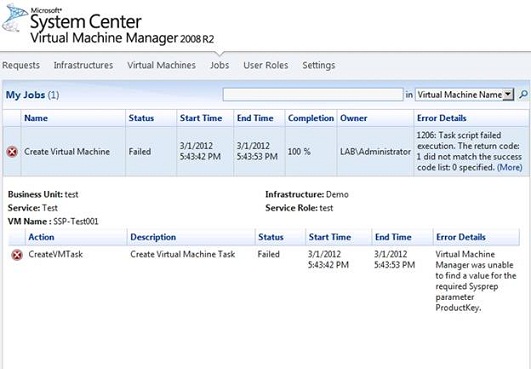Finally, we completed the process of installing Hyper-V to build your own private cloud. If you have been following this series since beginning, then you must be knowing what I am talking about. I hope that all of you got it right and were successful in generating user-friendly virtual machines. However, there might be some instances of something going wrong, but you don’t have to worry as we can get the things done the right way. This is the final part of the series where I will be demonstrating some troubleshooting techniques that will assist you in clearing the errors. Also, you will find some security guidelines at the end of this article.
Determine the technical issue
Despite of accomplishing all the configurations, there might occur an error during the creation process and you can monitor it in the Jobs tab. In this tab, you will find an error detail column that is certainly not helpful. To add on, the error displayed on the Job tabs are often hierarchical even though it is not mentioned that way. To make it easier for you to understand, check the image where I have provided a complete screen capture. In this image, you will see the errors are linked to each other only if you check the timings, which are similar. The Create Virtual Machine is a general error message that generates as a result of the first error message. But if you just clear the first in an appropriate way, then the primary error will automatically go away.

Uprooting the error
If you check the error detail, you will see it specifies that the VM was unable to find a value. This states that the Sysprep.inf file and ProductKey parameter is missing or is not being processed. Generally, this error occurs when the file is not stored in an exact location when you attempt to deploy images using the Windows Deployment Services. Secondly, you need to store the Sysprep.inf in a plain format. Ensure to follow these two crucial steps to avoid further errors. To simplify, add the missing Sysprep.inf file either to the OS configuration or the answer file.
Not just one, but you may come across several other errors, and the best thing to do is go to the web and find out an answer to it. There are number of websites including Microsoft available to provide a solution.
Self Service Portal - User Roles
As I mentioned in the previous article that I will be discussing about User Roles and its effective plus beneficial features, I will brief you on the topic. Among all other tabs, you will find User Roles that rolls down four built-in user roles, each with specific features and is used for specific purposes. This contains DCITAdmin, BUITAdmin and AdvancedOperator roles, all with similar privileges, but you can modify it based on your requirements. If required, you can also create a custom role.
Now, I would like to provide a suggestion which is not to modify the DCITAdmin and BUITAdmin roles as these are particularly designed for administrative purposes. You go ahead and AdvancedOperator and BusinessUnitUser roles, but avoid making changes to the other two options. Besides, you can also check the users that have been allotted to each roles and also add users to the role.
There is a lot of work involved in building your own private cloud via Hyper-V, but all the efforts will definitely benefit you in future administrative work. If you wish to modify the templates, you can do so whenever you need, since the process is relatively effortless.
